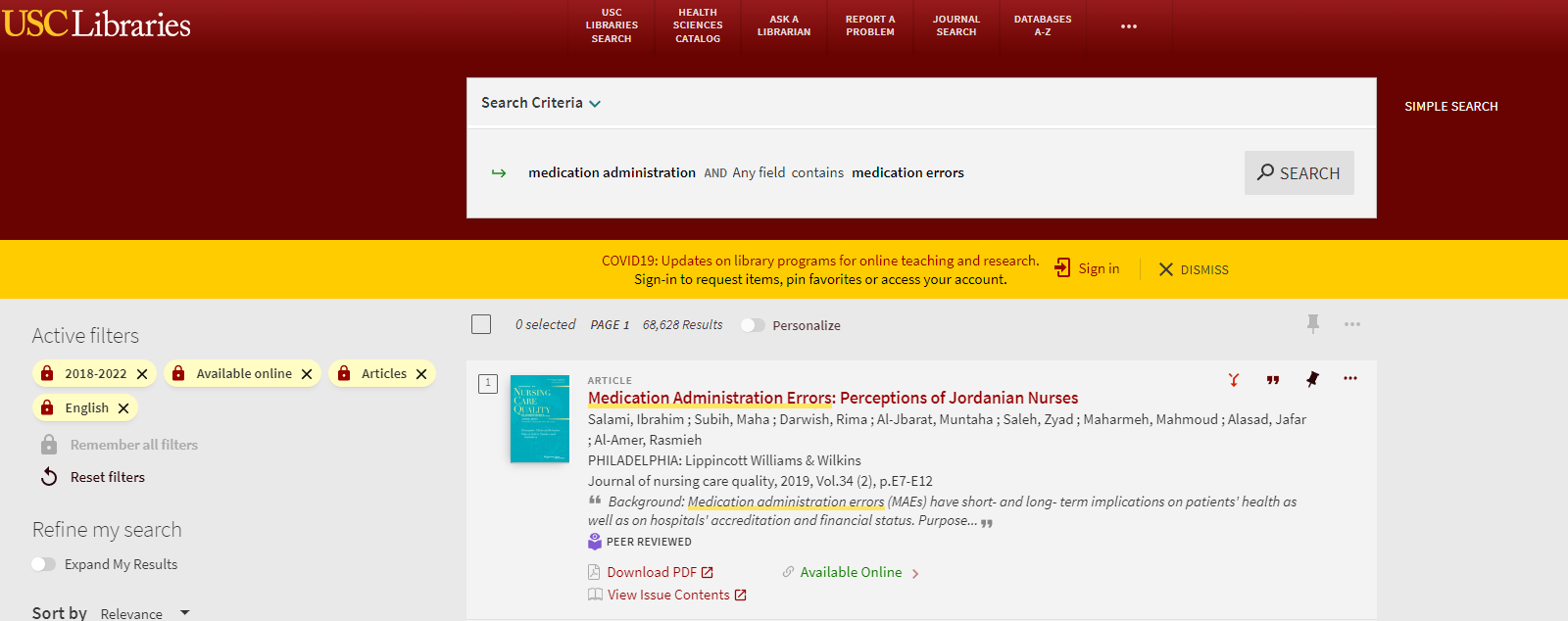A medication error is a preventable adverse effect of a patient taking the wrong medication or dosage, whether or not it is evident or harmful to the patient. Medication errors can be a source of serious patient harm, including death.
Potential Intervention Approaches:
- Medical staff education
- Packaging improvements
- Patient medication safety training
Keywords for Articles:
- medication administration, medication errors, medication safety
Search Results
Search 1. medication administration + medication errors

Berdot, S., Vilfaillot, A., Bezie, Y., Perrin, G., Berge, M., Corny, J.,… & Sabatier, B. (2021). Effectiveness of a ‘do not interrupt’vest intervention to reduce medication errors during medication administration: a multicenter cluster randomized controlled trial. BMC nursing, 20(1), 1-11.
The study focused on the impact that the “do not interrupt” vest has on the frequency of nurses’ medical errors. Interruptions can cause nurses to lose concentration or forget crucial information, which often leads to medication administration errors. Although the “do not interrupt” vests are used regularly in hospitals, there is a lack of academic study on the topic of its effect on the health care process. The randomized controlled cluster study involved 178 nurses and 1346 patients during 383 medication rounds in 14 units. The authors of the research measured such parameters as opportunity for error (OE), which were calculated by dividing the occurred errors to total opportunities for error (TOE). The main type of the medical error observed was wrong dosage form, which did not have a significant impact on patients’ health. As a result, the authors did not find a direct correlation between the number of occurred errors and nurses wearing “do not disturb” vests. In general, the source enhanced my knowledge of the topic by providing insights about the factor of interruptions and its effect on the medication administration errors. In addition, measures such as “do not disturb” vests are not effective in reducing the impact of interruptions.
Hada, A., & Coyer, F. (2021). Shift‐to‐shift nursing handover interventions associated with improved inpatient outcomes—Falls, pressure injuries and medication administration errors: An integrative review. Nursing & Health Sciences, 23(2), 337-351.
The article by Hada and Coyer (2021) investigates the issues associated with the shift-to-shift nursing handover. It is one of the healthcare events that may lead to misinformation about the patients. It is a risk factor for the increased falls, pressure injuries, and medication administration errors as well. Therefore, the authors investigated the effect of proper handover communication strategies on the rates of adverse events in the following shift. Medication administration errors after the handover may be associated with various factors such as lack of information provided by the previous nurse, lack of attention by a nurse that takes the shift, or misunderstanding due to improper communication strategy. Authors of the study conducted a literature review of the studies regarding the topic. The findings of their research have identified a significant reduction of falls, pressure injuries, and the medication administration errors associated with implementation of handover communication strategies. The source enhanced my understanding of the medication errors by analyzing the importance of the handover communication as a risk factor.
Keers, R. N., Plácido, M., Bennett, K., Clayton, K., Brown, P., & Ashcroft, D. M. (2018). What causes medication administration errors in a mental health hospital? A qualitative study with nursing staff. PloS one, 13(10), e0206233.
The article by Keers el al. (2018) investigated the most common reasons behind medication administration errors. Despite the topic being widely referred to, not much attention is paid to the causes and the nature of medication administration errors (MAEs). Such tendency prevents the effective development of evidence-based intervention strategies to reduce the number of MAEs in nursing practice. Hence, the study investigated the causes of MAEs in mental health National Heals Service (NHS). The combination of reports analysis and semi-structured interviews was used to capture the nurses’ experience and analyze the information to learn about key causes of MAEs. As a result, the authors identified that the majority of MAEs were related to skill-based slips and lapses (16 out of 26), 5 of them were mistakes, and the rest was caused by the risk factors such and patient behavior, medicines used, working environment or healthcare team. In conclusion, authors identified that understaffing is one of the major contributors to MAEs. In this source, the nurses’ perceptions on MAEs are gathered and they provide a better understanding of the healthcare workers experience that leads to errors.
Search 2. medication errors + medication safety

Alomari, A., Wilson, V., Solman, A., Bajorek, B., & Tinsley, P. (2018). Pediatric nurses’ perceptions of medication safety and medication error: A mixed methods study. Comprehensive child and adolescent nursing, 41(2), 94-110.
The article by Alomari et al. (2018) investigates the issue of medication administration errors in pediatric units. Specifically, the study focuses on the workplace culture of medication practice and explores the perceptions of nurses on why medication administration errors occur. Authors explain it by the importance of nurses’ role in the medication administration process. The study was based on observational method as observations where thematically analyzed. The key themes identified in the study were medication errors, the busyness of nurses, the physical environment, and compliance with medication policy and practice guidelines. Upon analysis, the authors identified that some of the major causes of medication administration errors in pediatric units were the lack of preparation space, poor physical environment design, high workload and frequent interruptions. Hence, the optimization of the working process and working environment is a key strategy in reducing the number of medication administration errors. The source provided a better insight on what factors contribute to the occurrence of MAEs.
